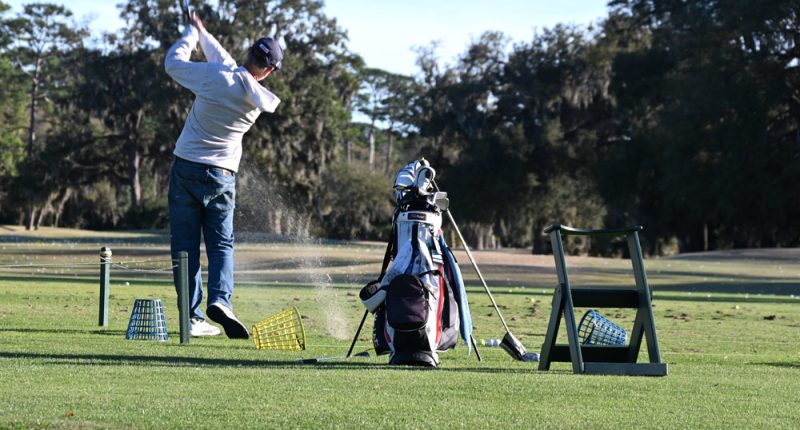
When Palm Coast City Council member Theresa Pontieri said she was “adamantly against” any suggestion to sell the city-owned Palm Harbor Golf Course in the heart of the C-Section, the audience burst in a round of applause. She was responding to a city presentation to the council today prompted by Council member Charles Gambaro’s assertion that the city cannot keep losing money on the course, and that selling the property should be at least an option to explore.
He was not applauded. But the discussion he prompted at a workshop today on what he and a majority of his colleagues on the council consider unsustainable losses at Palm Harbor Golf Club soon broadened to a discussion on the purpose of government and whether any city amenity should be losing money, whether it’s the golf course or the Southern Recreation Center or, presumably, other parks and the community centers: the city operations under the gun were not precisely defined, nor was the ultimate objective of today’s discussion. So its outcome is fuzzy.
The audience’s reaction to Pontieri was not a surprise. The 145-acre golf course has been a torrential money loser since it was donated to the city in 2008. But as Palm Coast landmarks that define the city and have the attachments of thousands of residents, it has few equals. Residents in the nearly 1,000 homes that surround the course’s snaky greens are also petrified that the course would either stop being a golf course, that its grounds would become unkempt and overgrown–as had the grounds of the old Matanzas Woods golf course when it stopped being a course in 2008, until it was turned over to a developer–or that it would be built up in turn, like so much of the city.
Mayor Mike Norris attempted to pre-empt discussions of development on the grounds when he asked City Attorney Marcus Duffy to summarize the legal status of the land. The property is part of a planned unit development, Duffy said. It is controlled by a deed that requires the land to be used either as a golf course or as a park or a recreational facility. While the city may sell the golf course, the same deed would apply to the buyer.
The assertion is at odds with a plan the city and Atlanta-based developer Jim Jacoby (who owns and has developed properties in Flagler County, and owns valuable land in Marineland) devised in 2019 to build 120 apartments in five three-story buildings in what is today part of the Palm Harbor Golf Club grounds. That plan was predicated on the developer ceding driving range ownership then owned by Centex Homes to the city. Then-City Manager Matt Morton said the plan was to the city’s benefit because the previously adopted master-planned development for the grounds had entitled the developer to 16 apartment buildings and nine more buildings on driving ranges. (See: “2 Big Developments Would Change Complexion of Palm Harbor Neighborhood.”
Residents swiftly rebelled. The plan was just as swiftly killed. The golf course stayed open.
“This is an area where we’re losing money, not just in fees. We have to reinvest some additional funding in it to continue this golf course to operate under the city,” Gambaro said. If it were privately owned, he said, it would generate property tax revenue. “We often talk about diversifying the tax base. We’ve got an immediate opportunity here to do that without having to court some company to come in from an economic development perspective.”
But it would not generate much. For comparison’s sake, the 170-acre Pine Lakes Golf Club off Pine Lakes Parkway in Palm Coast paid $21,750 in total property taxes last year, $5,000 of it to Palm Coast. Currently the Flagler County Property Appraiser gives the Palm Harbor course a lower just market value than that of the Pine Lakes course ($1.19 million compared with $848,000).
“I’m adamantly against that course of action. I am seeing right now coming through the pipeline requests to change fairways out at the Matanzas golf course for Lakeview Estates, to change fairways to residential, and that’s my fear.” In 2021, the Palm Coast City Council cleared the way for a residential development of more than 200 homes on what had been the Matanzas golf course in the L-Section.
Selling the property would be a first step to a similar fate for Palm Harbor, Pontieri said. While the finances of the golf course have to be brought under control, “this is an amenity,” Pontieri said. “We lose money on a lot of amenities–not something we should really brag about. But when you have amenities like this in the city there are a lot of things that we offer to the community that we lose money on.”
“The difference here is that golf is something that we have multiple other private entities providing that same service,” Council member Ty Miller said, “whereas some of the other things that the city offers are things that only the city can offer. So there’s a little bit of a difference there.” He is not opposed to selling the course, as long as the sale is conditioned on assurances that it would not be used for anything but golf.
Pontieri wanted facts that would enable a deeper analysis of next steps. But there were only so many new facts the city could present: it has been facing the same challenge at Palm Harbor since 2008, whether it was running the operation or whether a management firm was. The council agreed last year to higher fees, but the numbers aren’t all in regarding that windfall. The city has examined contracting some of the golf course’s operations while bringing others in house. The city has a management company for maintenance (which could be brough in-house, but at a higher cost), and has contracted the restaurant operation to Loopers.
Other ways of increasing revenue are limited. “We could pass on a credit card convenience fee to the customer, which could eliminate, eliminate about $50,000 to our budget,” James Hirst, the city’s parks and recreation director, said. Certain prices could be increased. To maintain the course, the city would have to spend money out of its capital improvement plan, further hurting the balance sheet.
Or the course could be sold, he said. The council would have to get the property appraised before selling it, but nothing stops it from selling. A majority of council embers would have to vote to sell it. If it were to continue as a private golf course, however, the city’s controls would be limited.
Pontieri’s view of the golf course as an amenity that loses money is in the minority. A majority of council members, including the mayor, want the course to at least break even, what they call “full cost recovery.” Norris is opposed to selling it. But based on anecdotal reports by golf players, he sees it as “overstaffed,” sees its prices as not competitive with other courses–but not put other courses out of business–and worries about players thieving rounds without paying (Hirst said staff keeps an eye on that) or thieving at the pro shop. He says all transactions should be cash-less. (None of those issues would amount to much of a difference in the bottom line, however.)
“There’s no reason why we’re having over 50,000 rounds of golf play there every year, and we’re bleeding money. That’s just ridiculous,” Norris said. “I think it goes a lot into the management.”
With one exception, none of the residents who spoke favored selling the golf course. One called it “a jewel of an amenity.” Most believe the course should not be losing money with as many rounds as it sells. “I am there all the time,” another resident said, recalling how local residents successfully prevented the city from building a cell tower there, to preserve the “jewel.” Several spoke of the value of a municipal golf course against private courses, which can be unaffordable. Some spoke of the course as a protection for their property value.
Doug Brown, the owner of Cypress Knoll Golf Course, who was attending the meeting with the owner of Pine Lakes Golf Club, said he’d offered the city to match up his profit and loss statement against those of the city, so the city could determine where it was losing. “I haven’t had a response to that at all,” he said. He did not outright say that the city should not be in the business of competing with private golf courses, but he spoke of the unfairness of the city “subsidizing” play for repeat users of the course–a contention a golf player at Palm Harbor said was inaccurate. The Pine Lakes owner said competing against the city for 10 years “has been an uphill battle.” While she advocates the sale of Palm Harbor, she said, the city bought the course to protect values.
Gambaro said he proposed a review of the golf course precisely to have the discussion that took place at today’s workshop of the City Council, and to consider options. But he went further: “What I would also like to see and post it on our website is the other amenities that we have,” he said. “The Southern Recreation Center, other places. How far in the red are we in those areas?” At that point Gambaro was putting in question the very purpose of local government and suggesting that amenities such as parks and community centers should not be losing money.
But that’s not reflective of the purpose of government-0-anymore than Belle Terre Parkway or Palm Coast Parkway, which cost millions to build and cost millions to maintain, do not and cannot make money. The arguable difference with a city-run golf club is that, as the resident who addressed the council today had noted, it is not a unique municipal service–it is not an essential municipal service, as regular parks and community centers and roads are.
“Let’s make all of it public,” Gambaro said, without specifying what “all” means. “I think if we’re going to take a look at all the numbers and see how we can better operate, if this is the consensus that this council decides to go with, let’s lay it all on the table, because if we’re bleeding millions of dollars over time, then we obviously need to do a better job in managing it.” He suggested creating a committee to study the matter. (The city had such an advisory committee. The council eliminated it on the recommendation of Lauren Johnston, now the acting manager.)
The most concrete direction the administration got today was merely to end cash transactions at the golf course, limiting them to credit cards or (presumably) cash apps, and to get profit and loss statements for an undefined list of other amenities, even though those numbers are posted routinely on the city’s financial transparency dashboard, on the web. The city will bring a cost and staffing analysis in a few months and attempt a full cost-recovery model, with a follow-up presentation in April.
“We’re operating on previous philosophies of previous city council, of what they want to invest in and what services they want to provide,” Acting City Manager Lauren Johnston said, “and then what cost recovery level that we’re asking to bring forth.”
But after a 70minute discussion, it was not clear how different today’s discussion was from the recurring discussions on the same topic that took place year after year, from around 2010 to 2017, when the golf course officially was redefined as an amenity, as opposed to a separate city fund.








